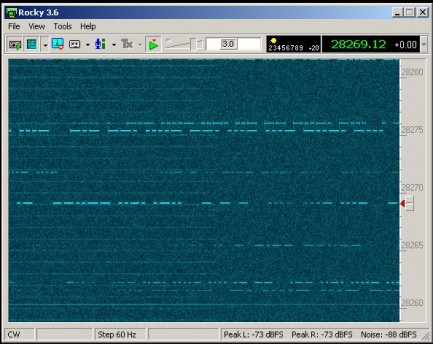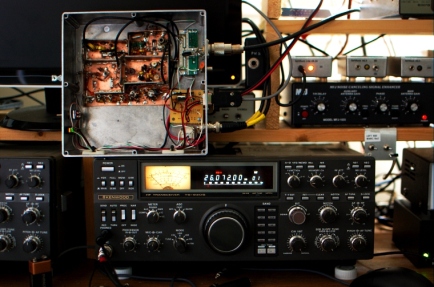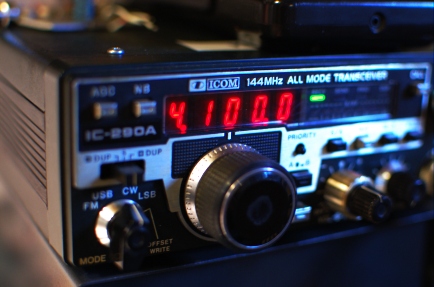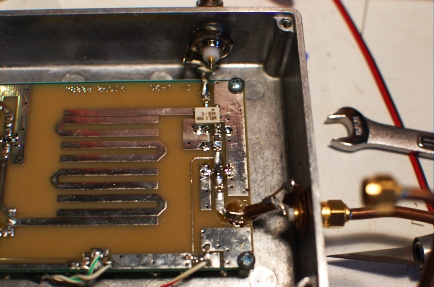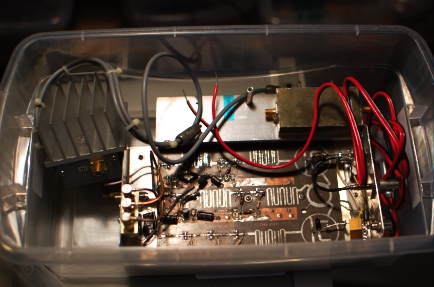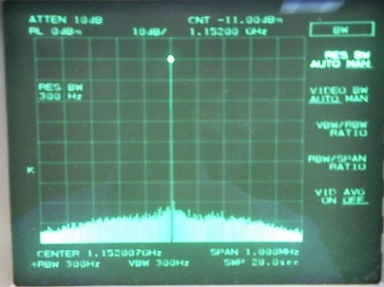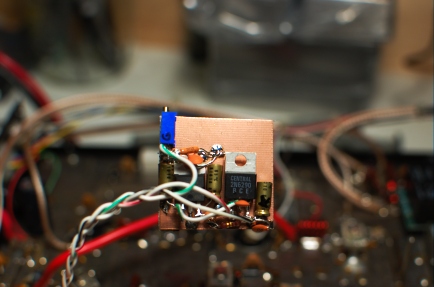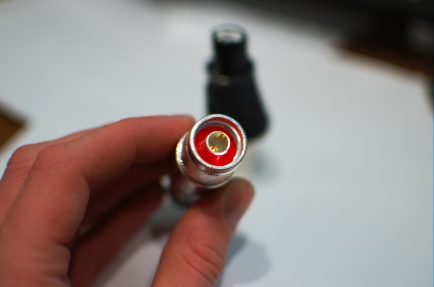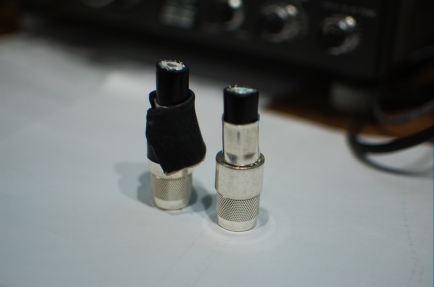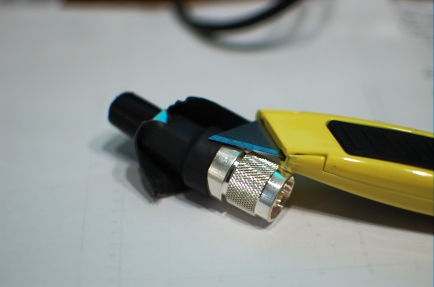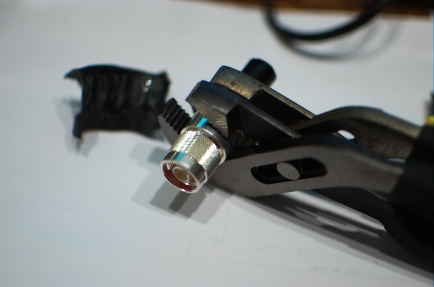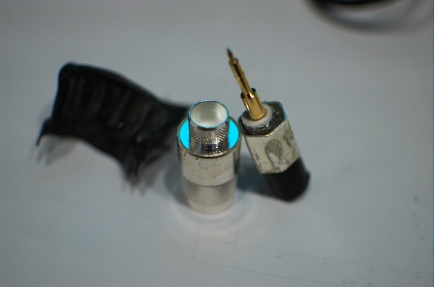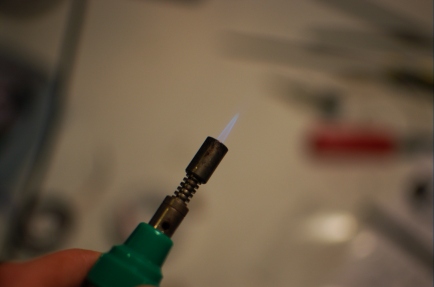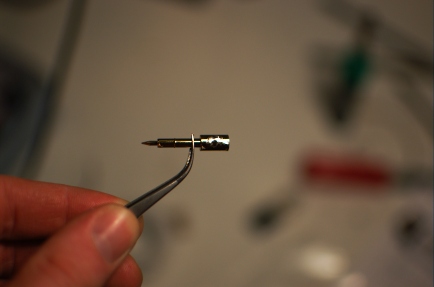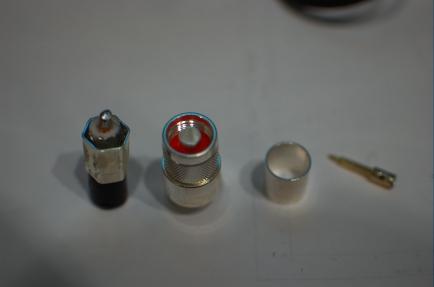Posts Tagged ‘cheap VHF’
 SoftRock v9.0 Lite+USB Xtall QRV
SoftRock v9.0 Lite+USB Xtall QRV
Got the SoftRock v9.0 Lite+USB Xtall working last night. I’m not 100% sure what the problem was, but I think it may have been due to me programming an ATTiny85 with the latest SoftRock firmware (V15.14), rather than using the supplied ATTiny45 with V15.4. So, I’m sticking with old version for now. Not sure if it was cockpit error on my part programming (more likely) or an incompatibility with the new firmware which is designed to work with the Ensemble series of SoftRocks.
As shown in the screenshot from Rocky above, there appears to be a spur that repeats every 1 kHz (see left side of the waterfall). The right side of the waterfall is with the USB cable unplugged from the computer. I’m 99% certain this is something internal to the SoftRock because I wrapped a few turns of the USB cable around a big type-31 ferrite toroid and the spurs are still there. So, need to play with that.
I’m listening to a Es opening to the south on 50 MHz right now using the SoftRock as the RX IF. Yes, that means that I got the RX on the transverter souped up a little hotter. I will post something about that later today and place a non-causal link in this post.
 Revisiting the 50-MHz Transverter
Revisiting the 50-MHz Transverter
I recently resurrected the 50-MHz transverter project and have made good headway getting it working. On Friday night, I began the process of tapping holes in the PA module heat spreader. But, despite using plenty of “cutting fluid” (3-in-1 oil), I managed to break a (well-used) tap on the first hole. Since the maximum (linear) power out of the driver stage is 200 mW, I embraced my inner QRPer and put the PA project aside to give the transverter a try in the CQ WW VHF contest.
The 6-meter Yagi had come down in favor of Yagis for 222 and 432 when the loaner FT-736R showed up. So, I scampered up onto the roof and moved Yagis around. I had hoped that this moment would be accompanied by changing out RG-8 coax for LMR-600 and LDF4-50A that are taking up space in the shop and shack. But, I was not ready to commit to cutting that and I still don’t have LMR-600UF for the rotator loops. Plus, I should replace the rotator at the same time. That amounted to too much work for the available time. I really just need to bite the bullet and install a rotating mast for the VHF antennas that’s not so precarious.
Got everything hooked up late on Saturday afternoon, but had to tend to some domestic concerns and was QRT until later in the evening when I heard my neighbor W4EE calling CQ on six SSB. Did not know that he had six! Apparently, this is a new thing for him, too. He was surprised that I didn’t vibrate his radio off the desk like I usually do! Told him I was running 200 mW and everything made sense.
Ended up working a few other locals on Sunday including N3UM, who moved me from 6-meter CW to 2-meter SSB for a quick chat. He just completed the N1DPM active bias mod to his Mirage B2518G, so was eager for an audio report. Sounds good! He said my B3016G sounded good on-frequency, but I haven’t gotten the mod actually inserted into mine yet. Probably that Kenwood (TS-700S) audio making up for the amp’s inferiority…
Eventually, I will be posting more details on the circuit here. This is one of those projects that I would not encourage anyone to duplicate as I have constructed it. However, there may be useful features.
 Microwave updates
Microwave updates
Apologies for the bad pun in the title. I was going to call it “Microwave progress” but could help myself when I thought of this one. Here are some notes from tinkering over the past few days.
1296 Mhz
After learning that the 1152-MHz LO power was -11 dBm, I inserted a MAR-3 MMIC on the 1296RSU transverter board. W1GHZ shows an MAR-6 on his board, but the ever-astute N3UM noticed that the P1dB for the MAR-6 is 1 dBm, which is well below the nominal 7 dBm level of the ADE-5 mixer. Unfortunately, the MAR-3 has about 12 dB of gain vs the MAR-6′s 20 dB. A little bit of skullin’ lead me to my stash of SGA-4586′s (suggested as an economical front end by W9SZ), which can do >20 dB gain with a P1dB point of 16 dBm or so. Perfect.
Unfortunately, with an 144-MHz IF drive of about 2 dBm, the 1296-MHz output was totally trashed with various mixing products. I spent about 20 minutes searching frantically for the 3-dB SMA attenuator I’d purchased at Dayton. But, I never found it—a sign that my organizational scheme has lost control or that I never actually bought the attenuator. Either are possible. So, I did the next logical thing—I added a Pi-network attenuator between the SGA-4586 “LO boost” MMIC and the ADE-5 mixer. If the Dremel tool didn’t make it’s inventor independently wealthy, it should have. The only SMD resistors that I had on-hand that were realistically appropriate (39.6 and 130 ohms) yielded about 6-7 dB of attenuation, so the effective gain of the SGA-4586/attenuator cascade was probably around 13-15 dB, yielding somewhere around 2-3 dBm of LO. Blech. That’s essentially the same as the MAR-3. The 1296-MHz output with 2 dBm of drive at 144 Mhz was about 2.5 dBm.
The data sheet for the ADE-5 suggests that the conversion loss increases as the LO drive level falls bellow 7 dBm (shocking!), but there are not enough data to show how precipitously it deteriorates. However, essentially 0.5 dB of overall power gain does not jibe with the amount of gain in the system, which should be closer to 20 dB. From this standpoint, perhaps the mixing products were due to IF overdrive instead of LO overdrive. In any event, about 3 dB (instead of 6 or 7 dB) of attenuation in the LO would be a good thing.
902/903 MHz
Fresh off my mixed success with the W1GHZ 1296RSU (which are neatly packaged in Hammond 1590BB-sized cast aluminum boxes), I wanted to give the 902/903 version (which is still loose boards) a try with the spectrum analyzer. So, I hooked up the 756LO board first. It made -5 dBm at 756 MHz. These numbers are more like what W1GHZ was promising. So, I put the MAR-3 mentioned above onto the 902/903 transverter board. With 2 dBm of 147-MHz drive, the output was a very clean 16 dBm on 903. Score! Must be livin’ right at least half the time. My last DigiKey order included a 1590BB for that transverter, but the 756LO board is a bit longer and I haven’t yet found a suitable case for it.
3456 MHz
Thought I was done? Me too.
I admit it. I’m a sucker for this sort of thing. Fred, N1DPM, recently posted to VHFcontesting and the “Stanford” VHF lists that he was selling a bunch of spare microwave gear, including a first-generation DEMI 3456 transverter/LO and some amplifiers to get the output up to 4 watts. Cheap. He had some 2304 stuff, but ye old project fund is pretty much depleted since Dayton and I always try to keep a little bit in reserve for just this sort of opportunity. Anyhow, the transverter is set up for 10 watts of drive on 144 MHz. I gave it 250 mW (24 dBm) from my modified IC-290A (post to follow on this—not rocket science, just bypassed the PA) and the output came up at -9 dBm on 3456 MHz. Once I remove the attenuator from the input, I should be able to get it up to about 13 dBm. At least it seems to work on TX. Need an antenna to try RX because the K3UO beacons are not as close as W3APL.
 W1GHZ 1152-MHz LO measurements
W1GHZ 1152-MHz LO measurements
Through some reorganization at work in the past two months, I have suddenly gained ready access to a lab full of RF test equipment again. Two years is a long time to go without. Apologies for the cell-phone photograph of the screen.
I took the W1GHZ 1152-MHz LO board over to have a look at it during lunch. I’m seeing -11 dBm at 1152.007 MHz. I am a bit dubious of the last digit of the frequency (even at 300 Hz RBW) but I’m sure there’s a frequency counter around somewhere. Anyhow, I need to put a MMIC (or two) on the transverter board. That should be a nice evening project along with the W6PQL preamp kit that showed up today.
 Mirage Active Bias mod, Part 1
Mirage Active Bias mod, Part 1
After chatting with Terry, W8ZN, about whether to keep or sell the AM-6155s (which I did sell to finance a tower), he suggested that I apply the N1DPM “Active Bias” modification to my elderly “160-watt” Mirage 2-meter amplifier. I contacted Fred, N1DPM, and he sent me a copy of his paper Linearization of Solid State “Brick” Amplifiers from the 21st Eastern VHF/UHF Conference (1995), along with some additional notes from his notebook. It’s pretty eye-opening how non-linear the amp is without the modification! I finally gathered the parts and hacked it together last night. Hope to test it soon with a “dummy” transistor and then live on the amp. The braided wires go to the thermal compensation transistor which is thermally bonded to one of the RF power transistors.
It probably won’t be ready for the ARRL June VHF this weekend, though. So, I’ll only be using the amp on CW. That’s no matter since I haven’t hung the low-loss cable (LMR and Heliax), nor have I received a D1010 432-MHz amp that will be on its way to me soon. Everything seems to take longer than it ought to!
 Recycling LMR crimp connectors
Recycling LMR crimp connectors
A while back, I came upon about two dozen Times Microwave Systems TC-600-NM connectors that had been improperly installed and cut off. Knowing that LMR-600 type cable is commonly available, I stashed them for later use. These connectors cost between $8 and $15 each, so the ability to recycle could offer a substantial savings. I endeavored to see just what it would take to do so.
The first step is to remove the heatshrink tubing (if installed). These connectors employed a relatively easy-to-remove heatshrink, which I was able to get off with a sharp knife. (That probably means that they would have filled with water if they had been used.)
Twist off the old crimp ring with two pair of Channel-Lock-type pliers.
Presto! (Be sure to do this in a work area where it is easy to vacuum up the small strands of braid that will invariably fall everywhere.)
A butane torch gets the pin off in no time.
Unfortunately, I did not have enough hands to take a photograph and demonstrate the proper technique. Place the tip of the flame on the widest (diameter) part of the pin and rotate the cut-off coax with the pin hanging down. The solder will melt and the pin will drop. Reinstallation can be performed in the exact opposite sequence with the pin sitting on top of the coax.
The secret to this whole operation is the replacement crimp rings. I originally was going to make them but since I did not know the dimensions, I was searching around the Web. And, I discovered that Times Microwave offers them individually (part #CR-600). So, I contacted Joel at The RF Connection and he sold me a bunch of them (second from right below) at an attractive price.
The three rightmost components—connector body, crimp ring, and solder pin, form a complete connector. You just need to add heatshrink, which is also available from the RF Connection and many other vendors. The trick to getting a correct installation on the connectors is to be sure that the pin seats (clicks) into the body before crimping the ring. The whole process of disassembly takes about as long as assembly (minus the stripping step)—just a few minutes.
I recently obtained about 250 ft (80 m) of LMR-600 pieces from various places for about what it costs to fill the gas tank in my Escort. So, this should be a relatively attractive cable for use at K8GU.
 The Rupture 2011
The Rupture 2011
Thanks to some quick thinking on Sarah’s part, I was able to attend the Hamvention (Saturday only—the day that the sewer backed-up and “ruptured”…spewing nasty water down through the fleamarket) for the first time in a few years. This is a recap from my perspective.
- Attendance was down. The fleamarket was shrinking.
- There were a lot of lookers but few buyers in the fleamarket. Predict that the fleamarket will shrink further next year.
- There were still good deals to be found in the fleamarket—I picked up some LMR-600, a WA2AAU 2304-MHz amp (unmodified 1900-MHz PCS amp), a Rohn 45G rotator plate, some 20-GHz rated SMA relays, and some miscellaneous parts. And, I passed on a few good deals as well.
- I saw a lot more young people than I remember from past years. Or maybe I’m just getting older and the population of hams younger than me is growing on account of that.
- Hamabouts (and their drivers) were not so obnoxious as prior years.
- Hara Arena may be a dump (K1LT told me the story—don’t know if it’s true—that during the Rolling Stones first U.S. tour, they had been booked at Hara, but refused to play when they saw the facility); but, it’s perfect for the riff-raff who show up for the Hamvention.
- In the end, the Hamvention (like ham radio itself) is about the people you know and meet. I had fabulous eyeball QSOs with guys from almost all phases of my ham career (except the early years from 1993-2000). The VHF/UHF weak signal crowd is a pretty amazing bunch of hams. I had a great time getting to know some of them in the fleamarket.
